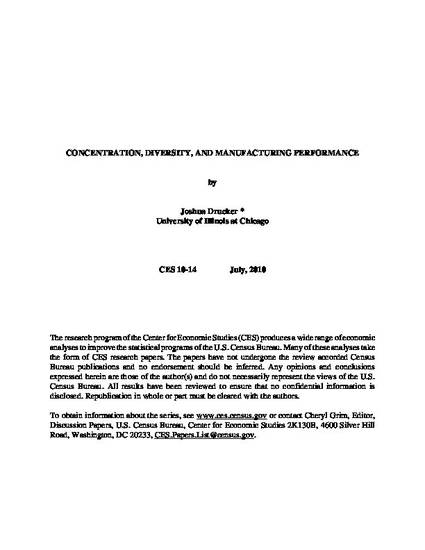
Unpublished Paper
Concentration, diversity, and manufacturing performance.
Center for Economic Studies, United States Census Bureau
(2010)
Abstract
(earlier version of Growth and Change 2013, https://onlinelibrary.wiley.com/doi/abs/10.1111/grow.12002)
Regional economist Benjamin Chinitz was one of the most successful proponents of the idea that
regional industrial structure is an important determinant of economic performance. His
influential article in the American Economic Review in 1961 prompted substantial research
measuring industrial structure at the regional scale and examining its relationships to economic
outcomes. A considerable portion of this work operationalized the concept of regional industrial
structure as sectoral diversity, the degree to which the composition of an economy is spread
across heterogeneous activities. Diversity is a relatively simple construct to measure and
interpret, but does not capture the implications of Chinitz’s ideas fully. The structure within
regional industries may also influence the performance of business enterprises. In particular,
regional intra-industry concentration—the extent to which an industry is dominated by a few
relatively large firms in a locality—has not appeared in empirical work studying economic
performance apart from individual case studies, principally because accurately measuring
concentration within a regional industry requires firm-level information. Multiple establishments
of varying sizes in a given locality may be part of the same firm. Therefore, secondary data
sources on establishment size distributions (such as County Business Patterns or aggregated
information from the Census of Manufactures) can yield only deceptive portrayals of the level of
regional industrial concentration. This paper uses the Longitudinal Research Database, a
confidential establishment-level dataset compiled by the United States Census Bureau, to
compare the influences of industrial diversity and intra-industry concentration upon regional and
firm-level economic outcomes. Manufacturing establishments are aggregated into firms and
several indicators of regional industrial concentration are calculated at multiple levels of
industrial aggregation. These concentration indicators, along with a regional sectoral diversity
measure, are related to employment change over time and incorporated into plant productivity
estimations, in order to examine and distinguish the relationships between the differing aspects
of regional industrial structure and economic performance. A better understanding of the
particular links between regional industrial structure and economic performance can be used to
improve economic development planning efforts. With continuing economic restructuring and
associated workforce dislocation in the United States and worldwide, industrial concentration
and over-specialization are separate mechanisms by which regions may “lock in” to particular
competencies and limit the capacity to adjust quickly and efficiently to changing markets and
technologies. The most appropriate and effective policies for improving economic adaptability
should reflect the structural characteristics that limit flexibility. This paper gauges the
consequences of distinct facets of regional industrial structure, adding new depth to the study of
regional industries by economic development planners and researchers.
Keywords
- plant size,
- agglomeration,
- manufacturing,
- productivity,
- industrial structure
Disciplines
Publication Date
2010
Citation Information
Joshua Drucker. "Concentration, diversity, and manufacturing performance." Center for Economic Studies, United States Census Bureau (2010) Available at: http://works.bepress.com/jdrucker/29/
